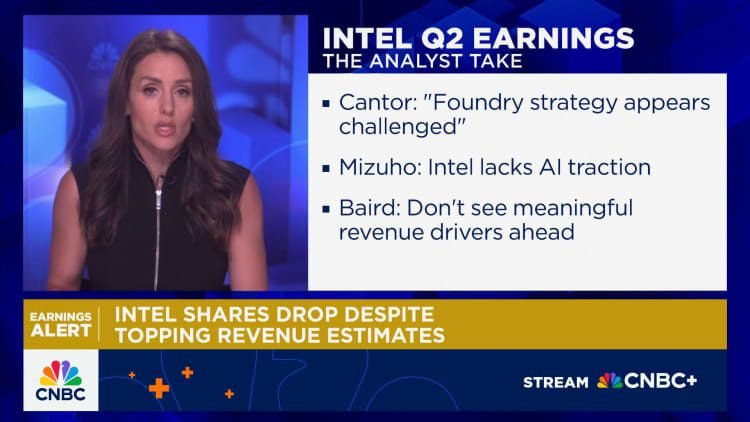Intel Faces Challenges Amid Restructuring Efforts
Intel, a major player in the semiconductor industry, recently experienced a significant drop in its stock price, plummeting by 9%. This decline came after the company announced it would be reducing foundry costs in an effort to turn around its struggling business.
Earnings Report Highlights
Despite the stock’s downturn, Intel’s latest earnings report was unexpectedly strong. The company surpassed revenue expectations and offered a sales forecast for the upcoming quarter that also exceeded analysts’ predictions. Adjusted earnings for the quarter were reported at 10 cents per share, surpassing the average analyst estimate of one cent, as noted by financial analysts.
Leadership Changes and Strategic Shifts
New CEO Lip-Bu Tan, who took over in March, addressed employees in a memo outlining the company’s strategy for its upcoming chip manufacturing process, named 14A. Tan emphasized the necessity of confirmed customer commitments before proceeding, stating that the era of "blank checks" for projects has ended. Intel has also signaled through a recent SEC filing that it may "pause or discontinue" foundry operations if it fails to secure a client for its next technology cycle.
Challenges in Securing Clients
In the filing, Intel acknowledged its struggle to attract significant external foundry clients for its manufacturing nodes. The company expressed uncertainty about securing major customers for the 14A technology, raising concerns about the future of its foundry business. Analysts have noted that the company must depend on large customer commitments to make its foundry model successful.
Year-to-Date Performance and Market Conditions
Intel’s stock performance in 2024 has been disappointing, having lost 60% of its value—its worst yearly performance ever. This downturn showcases the company’s challenges in gaining traction within the artificial intelligence sector, which has been overwhelmingly dominated by competitors like Nvidia. Furthermore, questions loom over Intel’s ambitious foundry plans, with many investors skeptical about its viability.
Operational Adjustments and Production Scaling
In response to these challenges, Intel has announced cuts to its chip facility projects in both Germany and Poland and is slowing down production at its Ohio plant. The strategic pivot aims to align operations more closely with actual customer demand, which Intel admits has been overly ambitious in previous years.
Workforce Changes and Cost Management
Under Tan’s leadership, Intel is implementing significant workforce reductions, aiming to cut 15% of its personnel. This decision is part of a broader effort to streamline operations and promote efficiency within the company, which is projected to end the year with a workforce of 75,000.
Financial Losses and Impairment Charges
The company’s net loss for the quarter widened to $2.9 billion, or 67 cents per share. This marks an increase from a net loss of $1.61 billion, or 38 cents per share, in the same period last year. Additionally, Intel reported an $800 million impairment charge related to excess tools without identified re-use, further compounding its financial challenges.
Industry Analysts Weigh In
Analysts from JPMorgan Chase commented on Intel’s recent decisions as a "positive step," but they also pointed out that ongoing losses in market share present a significant concern. Industry experts acknowledge the need for Intel to navigate these difficult waters carefully to regain traction in a competitive market.
Intel’s recent moves reflect a critical period for the company as it seeks to rebuild its reputation and market position amidst intense industry competition and shifting dynamics.
